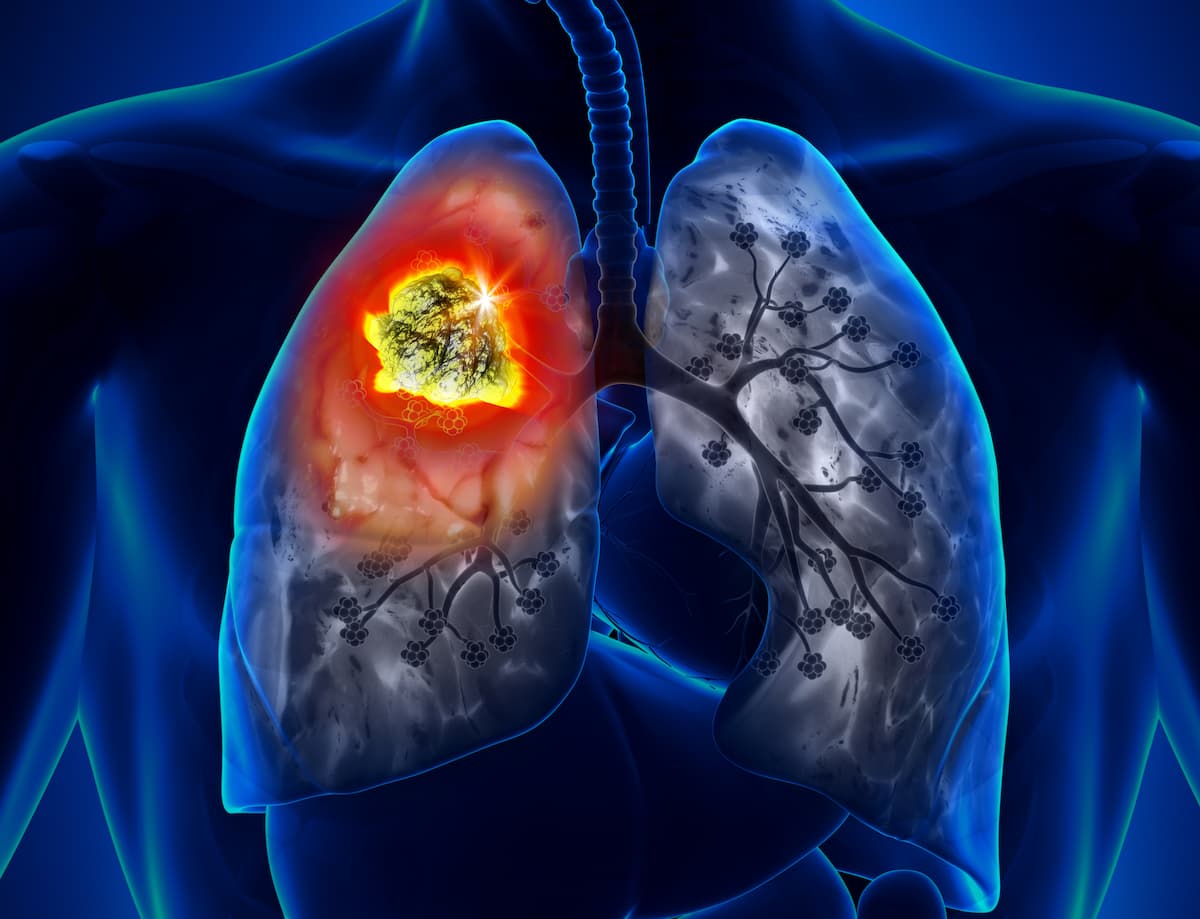Enhanced Dermatologic Care Reduced AEs from MARIPOSA Regimen in NSCLC
Doxycycline/minocycline, clindamycin, chlorhexidine, and a ceramides-based noncomedogenic moisturizer reduced skin- and nail-related AEs in NSCLC.
Doxycycline/minocycline, clindamycin, chlorhexidine, and a ceramides-based noncomedogenic moisturizer reduced skin- and nail-related AEs in NSCLC.

Interim results from the phase 2 COCOON trial (NCT06120140) showed that the primary end point of a reduction in the frequency of moderate-to-severe skin and nail adverse effects (AEs) and skin-related AEs compared with a standard dermatologic regimen in patients with newly diagnosed or locally advanced non–small cell lung cancer (NSCLC) who received first-line treatment with amivantamab-vmjw (Rybrevant) and lazertinib (Lazcluze), a press release from the developer, Johnson & Johnson, stated.1
Arm A consisted of amivantamab and Lazertinib plus standard dermatologic managementand either 100 mg of doxycycline or minocycline administered orally twice daily for up to 12 weeks; then clindamycin lotion 1%, a topical antibiotic rubbed on the scalp daily before bedtime between weeks 13 to 52; chlorhexidine 4%, an antibacterial wash applied to the fingernails and toenails daily; and a ceramides-based noncomedogenic moisturizer applied once daily on the body and face. Arm B consisted of amivantamab and lazertinib plus standard dermatologic management.2 Amivantamab was administered at 1050 mg or 1400 mg if 80 kg or less once a week for 4 weeks and then every 2 weeks after. Lazertinib was given at 240 mg orally every day.
Additionally, amivantamab plus lazertinib was approved by the FDA in August 2024 as a first-line treatment for patients with locally advanced or metastatic NSCLC with an EGFR exon 19 deletion or exon 21 L858R substitution mutation.3
“EGFR-targeted therapies are associated with dermatologic AEs, which can impact patients’ quality of life and treatment adherence, and are often treated reactively with topical/systemic corticosteroids and/or systemic antibiotics,” Byoung Chul Cho, MD, PhD, a professor of internal medicine at Yonsei University College of Medicine, and fellow authors, wrote in a presentation delivered at the 2024 World Conference on Lung Cancer.2 “COCOON aims to evaluate the impact of enhanced vs standard dermatologic management on the incidence of dermatologic AEs among patients receiving first-line amivantamab [plus] lazertinib.”
The overall safety profile of the 2 anticancer treatments, amivantamab and lazertinib, were meaningfully improved when given in accordance with the enhanced dermatologic regimen.
Additional results from the COCOON study are going to be presented at an upcoming scientific meeting.
The open-label, randomized phase 2 COCOON trial evaluated if the improved dermatologic management could reduce the incidence of grade 2 or higher dermatologic adverse effects of interest (DAEIs) compared with standard-of-care skin management in patients with locally advanced or metastatic stage IIIB/C-IV EGFR-mutated NSCLC in the first-line of treatment.
A total of 200 patients were enrolled in the trial and randomly assigned, in a 1:1 ratio, to either arm A or arm B. Patients in Arm A were given a digital health tool to monitor treatment compliance. Of note, all patients will receive skincare recommendations and be eligible for additional dermatologic measures at the physician’s discretion.
The trial’s primary end point was the number of patients with grade 2 or higher DAEIs within 12 weeks after beginning cancer treatment.4 Secondary end points include the number patients with DAEIs by severity, number of patients with grade 2 or higher DAEIs within 6 months of starting cancer treatment, number of grade 2 or higher DAEIs per patient, and time to first occurrence of a grade 2 or higher DAEI.
Eligible patients had histologically or cytologically confirmed, locally advanced or metastatic NSCLC harboring an EGFR exon 19del or exon 21 L858R substitution and are treatment-naïve and not amenable to curative therapy, including surgical resection or radiation. Patients with a history of brain metastases must have had all lesions treated to the point of no father definitive local therapies, and any definitive local therapy to brain metastases must have been completed 14 days prior to randomization; patients must have an ECOG performance status of 0 or 1 and they could have prior or concurrent second malignancy if it is unlikely to interfere with any study end points.
Exclusion criteria include history of uncontrolled illness including diabetes, infection, active bleeding diathesis, and refractory nausea and committing; medical history of interstitial lung disease; known allergy, hypersensitivity, or intolerance to the excipients of amivantamab, lazertinib, or to tetracyclines, doxycycline, minocycline, or their excipients; prior systemic treatment at any time for locally advanced stage III B/C or metastatic stage IV disease; or an active or past history of leptomeningeal disease.
According to the press release, the study protocol is going to be updated to include changes to Arms A and B, and will add a single-arm cohort for subcutaneous administration.
References
- COCOON study meets primary endpoint demonstrating statistically significant and clinically meaningful reduction in dermatologic reactions with easy-to-use prophylactic regimen for patients with EGFR-mutated NSCLC. News release. Johnson & Johnson. January 14, 2025. Accessed January 21, 2025. https://tinyurl.com/mskrts56
- Cho BC, Girard N, Sauder MB, et al. Enhanced vs standard dermatologic management with amivantamab-lazertinib in advanced NSCLC: phase 2 COCOON study. Presented at: IASLC 2024 World Conference on Lung Cancer; September 7-10, 2024; San Diego, CA. P3.12D.04.
- RYBREVANT® (amivantamab-vmjw) plus LAZCLUZE™ (lazertinib) approved in the U.S. as a first-line chemotherapy-free treatment for patients with EGFR-mutated advanced lung cancer. News release. Johnson & Johnson. August 20, 2024. Accessed August 20, 2024. https://tinyurl.com/yxc8u8t4
- Enhanced dermatological care to reduce rash and paronychia in epidermal growth factor receptor (EGRF)-mutated non-small cell lung cancer (NSCLC) treated first-line with amivantamab plus lazertinib (COCOON). ClinicalTrials.gov. Updated January 9, 2025. Accessed January 21, 2025. https://tinyurl.com/mr3dxt4z